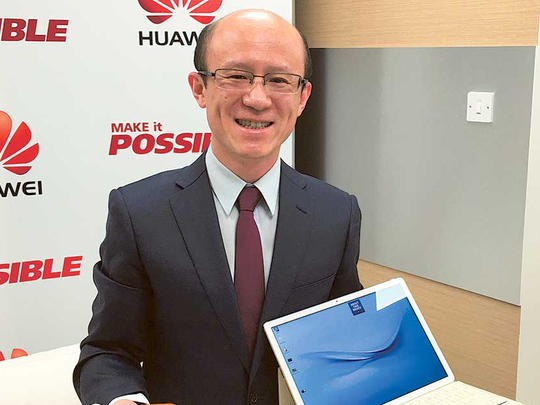
Dubai: Huawei Middle East is reaping its harvest after shifting its focus from a pure business-to-business (B2B) to business-to-consumer (B2C) company in the last four years.
The mobile phone manufacturer sold 108 million units in the last year globally, the first Chinese firm to do so and is ranked third. In the region, the second-ranked company has sold 6.5 million units.
Huawei also became the fourth mobile phone vendor in history to ship over 100 million smartphones in a year (preceded only by Nokia, Samsung and Apple).
Of the key brands originating from China, Huawei has consistently expanded its presence and share on the back of affordable handsets in emerging markets, combined with increasingly competitive flagship models.
In 2015, revenues grew more than 40 per cent while shipments grew 37 per cent compared to 2014 in the region.
According to research firm International Data Corporation (IDC), mature markets like the United States, China, and Western Europe all hit single digit growth in 2015, while high growth markets such as India, Indonesia, the Middle East and Africa, and other pockets in Southeast Asia, all remained healthy.
Gene Jijao, Regional President for Huawei Consumer Business Group, told Gulf News that the biggest business comes from middle- to high-end smartphones, more than 35 per cent of the total revenues, because the average selling price is increasing tremendously.
“Numbers is part of the game. We have built a solid foundation in 2015 as a brand in the region and expect to continue strengthening this year also,” he said.
According to Jijao, building the brand means getting closer to the customer and getting closer to the customer means to have dedicated service centres where customers can interact and learn about the devices.
“This is how we can absorb the customers and offer tailor-made and value-added services to the customers.
The region is very promising, said Jijao, and added that Middle East is one of the best growth places among emerging markets. Demand from Pakistan, Iraq and neighbouring Gulf states are strong.
“It is a strategic year for us to be in the leading position,” he said.
Even as the global smartphone market is expected to grow only seven per cent this year and the high-end market is a bit saturated, Jijao sees growth opportunities for the company.
“Four years ago, no one knew who we are, even in China. There is no doubt that Huawei has risen quickly but still we are building our brand globally,” he said.
According to research firm IHS, Samsung’s smartphone sales will fall by 1.25 per cent to 316 million units this year compared to 320 million units in 2015 while Apple’s sales will fall to 215 million units this year compared to 232 million units last year.
IDC expects overall Middle East mobile shipments to cross the 120 million mark in 2016, with smartphone shipments making up 75 per cent of the total. This will represent year-on-year growth of just 3.3 per cent, down from the 7.3 per cent growth seen in 2015.
Huawei expects further increase of 30 per cent in smartphone shipments, bringing the total to nearly 140 million units.
Surpassing either Apple or Samsung would be quite a challenge but Huawei has its own strategy.
Jijao echoed its global mobile head’s statement of becoming the becoming the number two player by 2019 and number one by 2021. Huawei is not present in the US markets but it is planning to forms partnerships with US carriers.
It has increased its brand awareness in the US with Nexus 6P, manufactured by Huawei.
It is surely going to be interesting to see what happens, Apple and Samsung beware.
While there is a lot of uncertainty around the economic slowdown in China, Melissa Chou, Senior Research Manager with research firm International Data Corporation, said that Huawei is one of the few brands from China that has successfully diversified worldwide, with almost half of its shipments going outside of China. Huawei is poised to be in a good position to hold onto a strong number three over the next year.
Analysts claim that Huawei is a threat to Samsung more than Apple. This is because a majority of smartphones from both the manufacturers use the Android platform while catering to different segments of the market.
With China’s smartphone market saturating, Huawei appears to be rapidly growing its overseas markets such as Africa, the Middle East and Latin America. A key reason for this is its close relationship with mobile carriers around the globe.
Jijao said that Huawei spent 14.5 per cent of the total revenues ($60.8 billion) on R&D, which translates to around $9 billion.
Over the last 10 years, the company has spent $37 billion on total R&D.
Moreover, Jijao said that Huawei topped the list of international patent filers in 2015 for the second year in a row.
According to World Intellectual Property Organisation (WIPO), Huawei applied for 3,898 patents, 456 more than the previous year, beating out other leading technology players including Qualcomm, Samsung, Sony, and HP.
Huawei’s domestic market — China — remained its biggest geography, followed by EMEA (Europe, Middle East and Africa), Asia-Pacific and the Americas.
In the region, Jijao said that Saudi Arabia is the biggest market, followed by rest of the Middle East.
Lenovo and Xiaomi, other two Chinese firms, are the ones that can challenge Huawei but Jijao is unfazed.
“We are not facing any pressure or competition from Lenovo and Xiaomi. Huawei can never be compared to these brands and we are poles apart,” he said.
“We are a global ICT company and are looking at the global market. I am confident that we would have more strong global growth in the future, with our innovation and technology capabilities. Our focus is to build the brand and bring value to the user as well as to the company,” he added.











